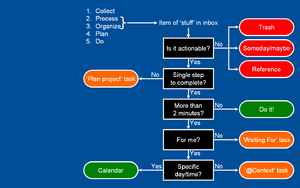Getting Things Done facts for kids
Getting Things Done (GTD) is a popular way to organize all the tasks and ideas you have. It's like a system for your brain! This method was created by David Allen, who also wrote a famous book about it.
The main idea behind Getting Things Done is super simple: if you write down everything you need to do, your mind doesn't have to remember it all. This frees up your brain to focus on just one task at a time, instead of worrying about everything else on your to-do list. It helps you feel less stressed and more in control of your schoolwork, chores, and fun activities.
Contents
What is Getting Things Done?
Getting Things Done, or GTD, is a system that helps you manage all your tasks, big or small. It's designed to help you clear your mind by getting all your thoughts, ideas, and to-dos out of your head and into a trusted system. This way, you can easily see what needs to be done and decide when and how to do it.
Why is GTD helpful for you?
For students, GTD can be a real game-changer. Imagine you have homework for different subjects, a project due, sports practice, and chores at home. It can feel like a lot to keep track of! GTD helps you:
- Reduce stress: By writing everything down, you don't have to worry about forgetting something important.
- Stay organized: You'll have a clear list of all your tasks in one place.
- Focus better: When your mind isn't busy remembering tasks, you can concentrate more on what you're doing right now.
- Get more done: With a clear plan, you can tackle tasks more efficiently.
How GTD Works: The Basics
The GTD method has a few main steps that help you take control of your tasks. Think of it as a simple process to manage all the "stuff" that comes into your life.
Step 1: Collect Everything
The first step is to gather everything that has your attention. This means writing down every single task, idea, or commitment you have. It could be homework assignments, a reminder to clean your room, an idea for a new hobby, or a book you want to read. You can use a notebook, an app, or even sticky notes. The goal is to get it all out of your head!
Step 2: Process What You've Collected
Once you've collected everything, you need to look at each item and decide what it is. Ask yourself:
- What is it? Is it a task, an idea, or just information?
- Does it require action? If not, you can throw it away, keep it for reference, or put it on a "someday/maybe" list.
- If it requires action, what's the very next step? For example, if "History project" is on your list, the next step might be "Research topic ideas."
Step 3: Organize Your Tasks
After processing, you put your tasks into different lists or categories. This helps you see what needs to be done and when. Some common ways to organize include:
- Next Actions: These are the very next steps you need to take on a project.
- Projects: Any goal that requires more than one step to complete (like a school project).
- Waiting For: Tasks you're waiting for someone else to do before you can continue.
- Calendar: Things that need to be done on a specific day or time.
- Someday/Maybe: Ideas or tasks you might want to do later, but not right now.
Step 4: Review Your System
It's important to regularly look at your lists and plans. David Allen suggests doing a "Weekly Review." This means taking some time each week to:
- Clear out your inbox (where you collect new items).
- Review your lists to make sure they are up-to-date.
- Plan for the upcoming week.
This review helps you stay on track and feel confident that you haven't missed anything important.
Step 5: Do Your Tasks!
Finally, the most important step is to actually do the tasks! With a clear system, you can choose what to work on with confidence, knowing that you're focusing on the right things at the right time. GTD helps you make smart choices about what to do next, whether it's studying for a test, finishing a chore, or spending time on a hobby.
See also
 In Spanish: Getting Things Done para niños
In Spanish: Getting Things Done para niños


